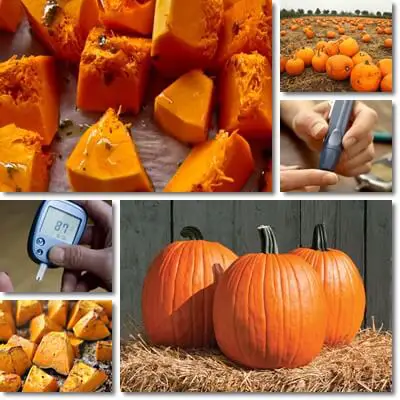Pumpkin season is here and, naturally, you may be wondering if it’s okay or even safe to eat the orange culinary vegetable if you have diabetes. There are actually reports of diabetics saying they can eat pumpkin without it spiking their blood sugar, while others admit they have felt sick after having the orange culinary vegetable. Naturally, the question on everyone’s minds is: can you eat pumpkin with diabetes safely and how is it likely to affect a diabetic’s blood sugar?
Truth is, pumpkin and diabetes are a sometimes difficult match. The biggest benefit of pumpkin specifically for diabetes is that it has a low carbohydrate and a low sugar content (6.5 g of carbohydrates per 100 g of which 2.76 g are sugars). Assuming a diabetic can have anywhere from 45 to 65 g of carbohydrates per meal, a serving of 100 g will amount to only 15% or 10% of the carbohydrates allowed in said meal, which is not much. Consequently, effects on blood sugar should be minimal.

However, the downside is that pumpkin has a moderate to high glycemic index (65 to 75), meaning it’s likely to have a marked glycemic effect and raise blood sugar levels fast. The more you eat, the more carbohydrates you’ll be getting and the higher the rise in blood sugar. The fact that there is little dietary fiber in the orange culinary vegetable (only 0.5 g of fiber/100 g) partly explains why it raises blood sugar so fast. Different cooking methods also affect the digestibility of the carbohydrates in pumpkin and the more easily digestible a food is, the faster it’s processed and the faster it makes blood sugar go up.
Pumpkin glycemic index: 65-75 (moderate to high)
The glycemic index (GI) is a scale that measures how fast the carbohydrates in a food raise blood sugar levels (carbohydrates are broken down into sugar during digestion and contribute to blood sugar levels; also, pumpkin and most fruit also contain actual sugar, the simplest form of a carbohydrate). Below 55 is a low GI. Between 55-69 is a moderate GI. Between 70-100 is a high GI.
Pumpkin glycemic index varies between 65 and 75, making it moderate to high, which means it’s likely to make blood sugar go up fast.
Pumpkin glycemic load: 4.2-4.8 (low)
The glycemic load (GL) measures how the carbohydrates in a serving of food raise blood sugar. Below 10 is a low GL. Between 11-19 is a moderate GL. Over 20 is a high GL.
Pumpkin glycemic load is 4.2 to 4.8, which is low (determined for a serving of 100 g with glycemic indexes of 65 and 75, respectively). So despite pumpkin having a high GI which makes it raise blood sugar fast, its low glycemic load (GL) means it ends up having an overall minimal effect on blood sugar metabolism. As long as you eat small amounts at once. So if you want to make the glycemic load matter, then remember to only have small servings.

Pumpkin and blood sugar effects
The effects of pumpkin on blood sugar depend on how much or how little you eat at once (so serving size). A small serving compensates for the high glycemic index and allows for a reduced overall effect on blood sugar metabolism. In other words, if you eat only 100 g, then you’ll be getting only 6.5 g of carbohydrates of which 2.76 g are simple sugars, 3.24 g other digestible carbohydrates and 0.5 g indigestible dietary fiber. Overall, it’s too small of an intake of carbohydrates for a diabetic to experience major shifts in blood sugar.
But if you eat too much, then effects on blood sugar are more pregnant simply because you are getting more carbohydrates. The more pumpkin you eat at once, the more carbohydrates you are getting and the higher the rise in blood sugar, which is not good for diabetes.
Best serving size for diabetes
The ideal serving size of pumpkin may vary from one diabetic to another. Factors such as carbohydrate content, sweetness (sugar content), choice of cooking method and cooking time (which influence carbohydrates digestibility) as well as the diabetic’s individual tolerance to carbohydrates in food (determined by degree of insulin resistance) all play a part in determining the ideal serving size.
In any case, it’s best to see a doctor or a dietitian with experience in diabetic diets and get a personalized eating plan that includes recommendations for carbohydrate intake per day and per meal. Based on this, calculate how much pumpkin you can fit into one of your meals without exceeding carbs recommendations.
How to eat pumpkin with diabetes
And here are my favorite tips and tricks to further reduce pumpkin effects on blood sugar metabolism:
1) Eat small amounts at once (small servings of the likes of 100-150-200 g).
2) No more than one serving a day. This also allows for variety in a diabetic diet.
3) Count your carbs in a serving so you can effectively predict glycemic effects.
4) Have your pumpkin serving after or during a meal containing light protein and some fat. Protein and fat slow down the rate of sugar absorption into the bloodstream and minimize glycemic effects.
5) Avoid pairing it with high-carbohydrate foods, fruits or sweets (sugar, honey, marshmallows etc.).
6) Simpler is better. For a reduced glycemic effect, pumpkin is best eaten plain – boiled, baked or roasted. Avoid pies, pastries or other baked sweets.
7) Spread your intake (serving) over the course of an entire day to further reduce glycemic effects.
8) Plan your meals ahead so you don’t exceed carbohydrate recommendations.
9) Exercise after having pumpkin to enjoy a better glycemic response and better insulin control.
10) Reduce cooking time when boiling, baking or roasting. The longer you cook it, the more readily digestible the carbohydrates in it become and the faster they’ll be absorbed, increasing glycemic effects. What I like to do is simply not cook my pumpkin all the way through – it still tastes wonderful and has a lesser glycemic effect.
Plain pumpkin puree is likely to have an increased glycemic effect. Pureed foods require even less digesting and are absorbed even faster than whole foods because of their form, causing blood sugar to go up fast. Adding fats such as butter, olive oil, nuts and seeds which pack lots of protein or even having some meat with the puree helps reduce its glycemic effects. And, of course, eating small amounts. The same applies to pumpkin soup.
Conclusion
You can eat pumpkin with diabetes safely so long as you have small amounts at once. Remember the carbohydrates in pumpkin get digested fast and the sugar obtained from them is absorbed just as fast into the bloodstream, which is why it’s best to limit intake. Serving size is best determined according to the diabetic patient’s individual nutritional requirements based on their carbohydrate recommendations per day and per meal, tolerance to carbohydrates in food, current weight, level of physical activity and according to the restrictions of their condition.
